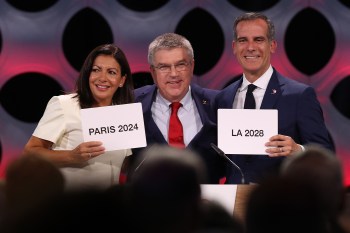TEXT OF INTERVIEW
Kai Ryssdal: The Los Angeles Philharmonic has a hotshot new music director. Gustavo Dudamel makes his debut performance at Disney Hall tonight. The program includes, aptly enough, a new piece by composer John Adams called “City Noir.” Los Angeles knows that particular genre pretty well — thanks to great authors like Raymond Chandler and James Ellroy, and some iconic movies like “Double Indemnity” and “Chinatown.”
[Audio from “Double Indemnity” and “Chinatown.”]
That’s L.A. in novels and on the big screen. But Los Angeles in real life? Author John Buntin says this city was quite a bit different at the turn of the last century.
JOHN BUNTIN: Los Angeles in 1875 was a dusty little pueblo of 5,000 people. Then, thanks to one of the most inspired marketing campaigns in history — one that touted Southern California as the center of health, wealth and leisure — Los Angeles started to grow.
The good press was nice. It certainly helped the city’s image and its economy. But in his new book “L.A. Noir,” John Buntin says that soon enough L.A.’s reality became less attractive. Those ads about sunshine and the sweet life didn’t just appeal to the good guys. Organized crime came, too. Gangsters eventually controlled politics here and a big chunk of the cash flow.
As John Buntin and I walk past the classic 1920’s movie houses that line Broadway in downtown Los Angeles, he introduces two of the main characters.
BUNTIN: One of the employees of Loews State was an 18-year-old kid who had just arrived in Los Angeles from Deadwood, South Dakota. His name was William Henry Parker III. And in time, in 1950, he would emerge as the chief of the LAPD. The person who created the Dragnet era, Los Angeles Police Department, and who later became Los Angeles’ greatest and most controversial police chief. While Parker was working as a movie usher in Lowes State, just a few blocks away another young man was beginning his career, a criminal career. His name was Myer Harris Cohen. His first violent crime was a hold-up of the Columbia movie theater. He got the money with the help of a baseball bat. He got nabbed by the cops, though, because he didn’t think about his getaway. He was also 9 years old. And in the decades that followed, Parker and Cohen would emerge as the two adversaries who battled it out for control of Los Angeles.
RYSSDAL: William Parker, who would later become the police chief, when he got here what was the relationship between the police and organized crime and the underworld that was helping Los Angeles grow? What was that like?
BUNTIN: Well, Parker was young, and it took him a while to catch on to what was happening. In 1927 he joined the LAPD, and as a rookie on probation quickly made the horrifying discovery that instead of trying to suppress crime, police in Los Angeles actually managed the criminal underworld. His great life calling would be to break the grip of the underworld on police and to do that he thought it was also important to free police from the control of politicians.
RYSSDAL: New York has finances. Chicago had the stockyards and everything else that it built on. Washington has government. Would Los Angeles be Los Angeles — and yes, there’s a Hollywood factor here — but would the city be what it is without crime in the underworld and that tension between the police and the bad guys?
BUNTIN: Los Angeles is a city which is not commonly known for its organized criminal underworld. But in fact in no other city did the underworld exercise as much influence in Los Angeles. It really wasn’t until the 1950s that control of Los Angeles was finally removed from the underworld.
RYSSDAL: John Buntin. His book is called “L.A. Noir.” John, thanks a lot for the tour.
BUNTIN: Thanks for having me, Kai.
There’s a lot happening in the world. Through it all, Marketplace is here for you.
You rely on Marketplace to break down the world’s events and tell you how it affects you in a fact-based, approachable way. We rely on your financial support to keep making that possible.
Your donation today powers the independent journalism that you rely on. For just $5/month, you can help sustain Marketplace so we can keep reporting on the things that matter to you.


















